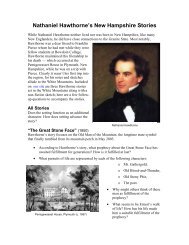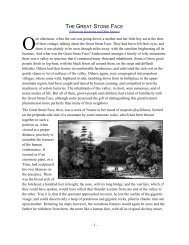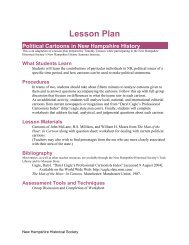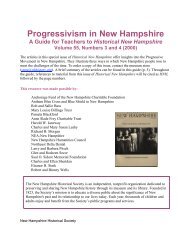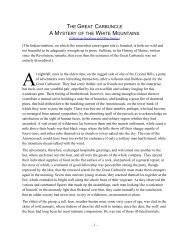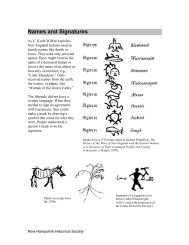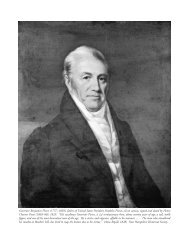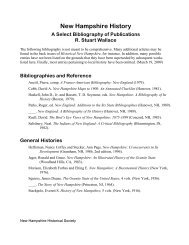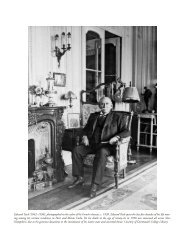Industrial Development in New Hampshire: A Timeline
Industrial Development in New Hampshire: A Timeline
Industrial Development in New Hampshire: A Timeline
Create successful ePaper yourself
Turn your PDF publications into a flip-book with our unique Google optimized e-Paper software.
<strong>Industrial</strong> <strong>Development</strong> <strong>in</strong> <strong>New</strong> <strong>Hampshire</strong>:<br />
A Timel<strong>in</strong>e<br />
Note: Italicized entries <strong>in</strong>dicate national events or developments that affected <strong>in</strong>dustrialization <strong>in</strong><br />
<strong>New</strong> <strong>Hampshire</strong>.<br />
Up to 1623 .... Prior to contact, Abenaki use stone tools <strong>in</strong> hunt<strong>in</strong>g, fish<strong>in</strong>g, and agriculture. Practice<br />
seasonal burn<strong>in</strong>g to control underbrush and prepare for plant<strong>in</strong>g.<br />
1634 ............. First shipment of masts leaves for England. Regular shipments are made by 1654. Along<br />
with fish<strong>in</strong>g, forest products form the backbone of NH’s colonial economy; brickmak<strong>in</strong>g<br />
for local use (chimneys) among the first <strong>in</strong>dustries established<br />
1705 ............. Piscataqua River is l<strong>in</strong>ed with sawmills and is one of the most densely <strong>in</strong>dustrialized areas<br />
<strong>in</strong> the world prior to the <strong>Industrial</strong> Revolution.<br />
1700s ........... Products are made <strong>in</strong> homes and artisans’ workshops. Production is slow as goods are<br />
made by hand. Scots-Irish immigrants <strong>in</strong> Londonderry weave l<strong>in</strong>en <strong>in</strong>to a high quality<br />
cloth <strong>in</strong> their homes<br />
1787 ............. Samuel Slater and Moses Brown beg<strong>in</strong> operation of first textile factory <strong>in</strong> America, located<br />
on the Blackstone River <strong>in</strong> R.I.<br />
1793 ............. Eli Whitney patents the cotton g<strong>in</strong><br />
1804 ............. First cotton mill <strong>in</strong> NH opens <strong>in</strong> <strong>New</strong> Ipswich.<br />
1807-12 ........ Jefferson’s embargo br<strong>in</strong>gs shipp<strong>in</strong>g to a standstill. Merchants beg<strong>in</strong> to <strong>in</strong>vest <strong>in</strong> emerg<strong>in</strong>g<br />
textile <strong>in</strong>dustry. War of 1812 further affects shipp<strong>in</strong>g<br />
1807 ............. Completion of canal around Amoskeag Falls<br />
1810 ............. Amoskeag Cotton & Mfg. Co. is established; granite <strong>in</strong>dustry beg<strong>in</strong>s <strong>in</strong> Concord with<br />
contracted prison labor<br />
1811 ............. Meredith Cotton & Woolen Co. <strong>in</strong> Laconia; burned <strong>in</strong> 1823, replaced with present brick<br />
build<strong>in</strong>g known today as the Belknap Mill<br />
1812 ............. Cocheco Mill <strong>in</strong> Dover opens. War of 1812 further affects shipp<strong>in</strong>g<br />
1813 ............. Completion of Middlesex Canal <strong>in</strong> Mass. soon allows boat travel from Concord to Boston;<br />
Boston Company founded, <strong>in</strong>vests capital <strong>in</strong> textile factories throughout <strong>New</strong> England;<br />
Keene’s Faulkner & Colony Co. weaves flannel cloth, which would later be the fabric of<br />
choice for gold prospectors <strong>in</strong> Calif.; Lewis Down<strong>in</strong>g, a wheelwright who made buggies,<br />
founds a wheelwright bus<strong>in</strong>ess <strong>in</strong> Concord<br />
1818 ............. State House completed with granite from nearby Rattlesnake Hill<br />
1821 ............. Site on the lower Merrimack’s Pawtucket Falls chosen to be the site of the mills of Lowell,<br />
Mass.<br />
<strong>New</strong> <strong>Hampshire</strong> Historical Society
1822 ............. Two textile mills on Salmon Falls River <strong>in</strong> Somersworth<br />
1823 ............. First shoe factory <strong>in</strong> NH opens <strong>in</strong> Weare, and others follow <strong>in</strong> Rochester, Farm<strong>in</strong>gton &<br />
Dover; Nashua Manufactur<strong>in</strong>g Co. opens; there are 56 woolen card<strong>in</strong>g mills <strong>in</strong> NH. First<br />
mills of Lowell beg<strong>in</strong> manufactur<strong>in</strong>g cotton textiles<br />
1825 ............. Concord becomes greatest producer of granite <strong>in</strong> <strong>New</strong> England; stone used <strong>in</strong> construction<br />
of Qu<strong>in</strong>cy Market <strong>in</strong> Boston<br />
1826 ............. Stephen Abbot jo<strong>in</strong>s Lewis Down<strong>in</strong>g’s staff<br />
1827 ............. Abbot and Down<strong>in</strong>g, now partners, complete first Concord Coach<br />
1820s-40s ..... Farm girls from N.H. communities supply labor for mills<br />
1828 ............. 400 women at Dover’s Cocheco mills strike, one of the first women’s strikes <strong>in</strong> the nation.<br />
1831 ............. Amoskeag Mfg. Co. is reorganized and buys much of land on banks of the Merrimack <strong>in</strong><br />
Manchester<br />
1838 ............. First railroad <strong>in</strong> NH connects Nashua and Lowell, Mass.<br />
1850s ........... Irish immigrants beg<strong>in</strong> to replace farm girls <strong>in</strong> mills<br />
1850 ............. 44 Cotton and 61 woolen mills <strong>in</strong> NH<br />
1851 ............. Amoskeag textiles w<strong>in</strong> top honors at London’s World Fair<br />
1854 .............. Mob violence erupts between Manchester Irish and Yankees<br />
1856 ............. Walter Aiken beg<strong>in</strong>s market<strong>in</strong>g circular knitt<strong>in</strong>g mach<strong>in</strong>es<br />
1850-70 ........ Harrisville’s woolen mills undergo greatest period of growth<br />
1861-65 ........ Civil War cuts off supply of cotton from South; Amoskeag shifts production to soldiers’<br />
uniforms, rifles, & locomotives; Belknap Mill knits socks for soldiers<br />
1870 ............. A Concord Coach costs $1200 to build<br />
1874 ............. Eleven granite quarries <strong>in</strong> Concord employ 500, many immigrants from Italy, Ireland, and<br />
Sweden<br />
1878 ............. Natt & William F. Head of Hooksett produce 5,000,000 bricks each year<br />
1880 ............. NH produces 54 million bricks; 13 brickyards <strong>in</strong> Plaistow employ 125 men to produce<br />
11,000,000 bricks<br />
1882 ............. Electric power lights the streets of Manchester and Berl<strong>in</strong><br />
1880s ........... Amoskeag’s employee welfare programs provide dental care, hous<strong>in</strong>g, and provisions for<br />
mortgages, health care, and playgrounds to ensure loyalty of workers<br />
<strong>Industrial</strong> <strong>Development</strong> <strong>in</strong> <strong>New</strong> <strong>Hampshire</strong>: A Timel<strong>in</strong>e 2
1890 ............. Peak of granite production <strong>in</strong> Concord—20 quarries and 44 cutters and dealers comb<strong>in</strong><strong>in</strong>g<br />
to employ 1,000<br />
U.S. Census—Manchester’s foreign-born population is 45.5%; <strong>in</strong> addition to Irish and<br />
French-Canadians, immigrant groups <strong>in</strong>clude Germans, Greeks, Scots, & Poles. French<br />
Canadians represent 28% of total. Each group has its own church and social groups<br />
1892 ............. Six month strike by Concord’s stonecutters<br />
1893 .............. Beg<strong>in</strong>n<strong>in</strong>g of worst depression <strong>in</strong> America to this po<strong>in</strong>t<br />
1896 ............. 31,000 tons of granite shipped from Concord; this was a “dull” year<br />
1898 ............. Last salmon seen on Merrimack River<br />
1905 ............. NH Child labor laws restrict children under 14 to be employed full-time; many violations<br />
resulted from poor enforcement<br />
1906 .............. Berl<strong>in</strong> Mills is world’s largest producer of chemical pulp paper<br />
1909 ............. Photographer Lewis H<strong>in</strong>e visits N. <strong>New</strong> England to document child labor abuses <strong>in</strong> mill<br />
cities like Manchester, Dover, and Lewiston, Me.<br />
1912 ............. Amoskeag is largest textile producer <strong>in</strong> the world employ<strong>in</strong>g 15,000 workers; 31 factories<br />
produce 147,000 miles of cloth, enough to circle the world 6 times.<br />
1914-18 ........ World War I <strong>in</strong>creases global demand for Amoskeag textiles<br />
1922 ............. First strike at Amoskeag<br />
1923 ............. Dover’s Samuel Horne brickyard produces 40,000,000 bricks s<strong>in</strong>ce 1865<br />
1925 ............. Abbot-Down<strong>in</strong>g Co. is dissolved<br />
1929 ............. Stock Market crash leads to Depression with fatal consequences for N.H. factories<br />
1933-34 ........ Violent strikes <strong>in</strong> Manchester<br />
1935 ............. Amoskeag files for bankruptcy on Christmas Eve; flood of follow<strong>in</strong>g year thwarts any<br />
attempt at reorganization<br />
1968 ............. Urban renewal plan for Manchester tears down many mill build<strong>in</strong>gs and fills <strong>in</strong> canal to<br />
make room for auto traffic.<br />
1974 ............. Belknap Mill purchased by a non-profit agency to convert build<strong>in</strong>g <strong>in</strong>to a cultural center<br />
1990 ............. Concord’s last rema<strong>in</strong><strong>in</strong>g granite company, Swenson Granite Co., is largest producer of<br />
granite <strong>in</strong> North America, provid<strong>in</strong>g 60 miles of road curb<strong>in</strong>g annually<br />
<strong>Industrial</strong> <strong>Development</strong> <strong>in</strong> <strong>New</strong> <strong>Hampshire</strong>: A Timel<strong>in</strong>e 3



